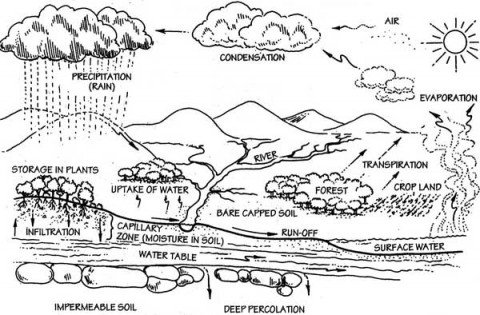Short description: The water cycle, also known as the hydrological cycle or the hydrologic cycle, describes the continuous movement of water on, above and below the surface of the Earth.
Fresh water sources are replenished in a water cycle through various processes.
Introduction
Every living creature and vegetation must have water in order to survive. Clean and fresh water falls as rains from the clouds at no costs at all. Why not use it?
Only 3% of all water on Earth is fresh water and 68% of the water is frozen ice on the North and South Poles. All humans and most animals as well as nearly all vegetation can only survive on fresh water free of salt and minerals. Water for irrigation must also be fresh water and applied sparingly by flood, furrow or drip irrigation, otherwise the irrigated soil will turn saline and unproductive for many years to come.
The other 97% of the water on planet Earth is saline seawater in which whales, fish, corals and plankton flourish. Slightly salty water may be used for watering livestock and other animals, although fresh water is healthier.
Nearly half of all deep boreholes are dry or contain saline (brackish) water with minerals harmful to humans, animals and irrigation. Where fresh water is pumped up from deep boreholes it is called mining fossil water because the drawn water cannot be replaced by rains.
Therefore, there is only two sustainable solutions to the world's increasing demand for water, namely rainwater harvesting and water conservation.
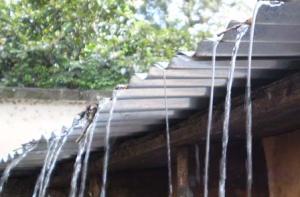 |
| Don't waste rainwater falling on the roof |
| © E. Nissen-Petersen, Kenya |
Most people waste the rainwater falling on their roof, although it could supply them with free and clean water throughout the years, if they store the water in tanks. For example, where 100 millimetres (mm) of rain falls on 100 square metres (sq.m.) of roof, it provides 10,000 litres of water sufficient to fill 500 jerry-cans which is more than 1 jerry-can of water every day next to the house throughout the years.
 |
| Don't waste rainwater falling on the road |
| © E. Nissen-Petersen, Kenya |
Another example: where 100 mm of rain falls on a 1 km long murram road, it could provide 1/2 million litres of water that could be stored in ponds, earth dams or in the sand of riverbeds. If half of the water is lost to evaporation and seepage, then the other half is sufficient to water 30 local cattle for a full year or to drip irrigate 10 acres or to flood irrigate 10 acres for a season of 90 days.
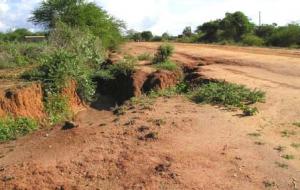 |
| Deep gullies in the road |
| © E. Nissen-Petersen, Kenya |
Unfortunately, only few people know how make profitable farming from harvesting rainwater run-off from roads. Instead they let the rain ruin the roads, carry away the top soil and cut deep gullies in adjacent farmland.
Water cycle
Fresh water sources are replenished in a water cycle through the following activities:
- Evaporation is an almost invisible vapour rising from water surfaces.
- Transpiration is evaporation from vegetation and soil surfaces.
- Evaporation and transpiration create clouds.
- Precipitation from clouds falls as fogs, mists, rains, hails and snow.
- Rainwater run-off is rainwater running off all kind of surfaces.
- Drainage is the ability to drain excess water away from catchments.
- Infiltration is the movement of water into the soil from the surface.
- Percolation is the movement of water through the soil to the underground layers.
- Permeability is the rate at which water penetrates through soils down into the underground water. table.
- In situ storage is storage of water in the voids between particles of soil and sand.
- Subsurface flow is a flow of water in the voids of soil and sand particles.
|
|
|
This illustration of the water cycle shows the way of the water from the ocean, through the atmosphere, brought back to the earth by rain, evaporating again or flowing back to the see, either as surface water or in groundwater flows (Vukasin et al. 1995). |
| © Natural Farming Network 1995 |
Water can be harvested at several stages in the water cycle, such as:
- Fog screens placed on hills, mountains and near the sea for domestic water.
- Gutters attached to roofs for domestic water.
- Garlands of stone gutters on rock outcrops for domestic water.
- Soil bunds and trenches on farmland for crops and animals.
- Diversion trenches from roads, rocks and hillsides for seasonal flood irrigation.
- Hand dug wells in shallow ground water to supply water for all uses.
- Subsurface dams, weirs and sand dams to increase the yield of hand dug wells situated along seasonal water courses.
- Boreholes drilled into deep ground water where none of the above options are replicable, although expensive and up to 40% may not supply fresh water.
The quality of water from all these sources can be tested by either a portable testing kit or by a laboratory if the samples can be delivered before deteriorating due to heat over long distances. Contaminated water may be treated by several methods, such as SODIS (Solar disinfection), boiling, water filters, crushed seeds from the Moringa tree, ultra-violet rays (UV) or artificial chemicals. For more information on water treatment click here
Rainfall
Although it is known that clouds can be seeded with chemicals to produce rains, the practice is expensive and unsustainable. It should therefore be realized that rainfall varies from region to region and from one year to another beyond peoples' manipulation and interference.
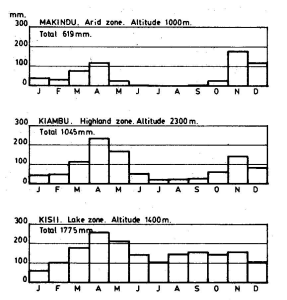 |
| Average monthly rainfall |
|
© E. Nissen-Petersen (1982) |
The North-East monsoon coming from India brings rains to East Africa from October to December every year. The South-East monsoon brings rains from March to June. Rain falls where and when the two monsoons meet. The area of convergence is called the Inter-Tropical Convergence Zone. This zone follows the apparent movement of the sun, north and south, bringing rain in its wake. But the pattern is influenced by mountain ranges, Lake Victoria and periodic westerly winds from the Atlantic.
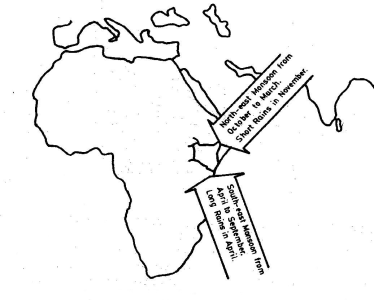 |
| The two monsoons affecting Kenya |
|
© E. Nissen-Petersen (1982) |
Information Source Links
- The Web of Rain: www.gdrc.org
- Water for Arid Land: www.waterforaridland.com

